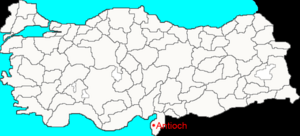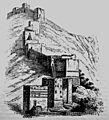Antioch facts for kids
Antioch on the Orontes was a very old city located on the Orontes River in what is now Antakya, Turkey. It was founded around 300 BC by Seleucus I Nicator. He was one of Alexander the Great's generals.
Antioch grew to be a very important city. It was a big rival to Alexandria in Egypt. It was also a key place where Christianity first spread to non-Jewish people. Antioch was one of four main cities in the region called the Syrian tetrapolis.
The city's location was great for trade and control of Syria. This made it a very important center for many powerful groups. During the Crusades, Christian armies tried to capture Antioch. The Siege of Antioch was a major event in these wars.
History of Antioch
Even before Antioch was founded, Alexander the Great is believed to have camped there. He even built an altar to Zeus Bottiaeus.
After Alexander the Great died in 323 BC, his generals divided his huge empire. Seleucus I Nicator took control of Syria. He then founded four "sister cities" in northwestern Syria. These were Antioch, Seleucia Pieria, Apamea, and Laodicea-on-the-Sea. At first, Seleucia Pieria was the main capital. But Antioch quickly became the most important city in Syria.
The city of Antioch was designed by an architect named Xenarius. Its layout was similar to the famous city of Alexandria. The first people to live in Antioch came from different places. There were local people, Athenians, Macedonians, and Jews. The Jewish people were given full rights from the start.
When it was founded, Antioch had about 17,000 to 25,000 free people. This number does not include slaves. During its busiest times, the city's population grew very large. It reached over 500,000 people. This made it one of the largest cities in the world. Only Rome and Alexandria were bigger. By the 4th century, the population was around 200,000 people.
Antioch became the capital of the western part of the Seleucid empire. Antiochus I made it his main city.
The Romans later took control of Antioch. Roman emperors liked the city a lot. They saw it as a good capital for the eastern part of their empire. They even tried to make it like a second Rome in the East.
Antioch is very important in the history of Christianity. Some traditions say that Peter visited the city. It is certain that Barnabas and Paul taught there. Paul even gave his first Christian sermon in a synagogue in Antioch. The people who became Christians in Antioch were the first ones to be called "Christians." This is mentioned in the Bible (Acts 11:26).
In the year 638, during the rule of the Byzantine emperor Heraclius, Muslim Arabs conquered Antioch. This happened during the Battle of Iron bridge. The city then became known as Antākiyyah in Arabic.
Today, much of the ancient city is gone. Modern building in Antakya has damaged many old Roman structures. For example, the last Roman bridge was taken down in the 1960s. New construction often uncovers parts of the old city. Sadly, these ancient remains are often destroyed instead of being protected.
Images for kids
-
An ancient Roman road in Syria. It connected Antioch and Chalcis.
-
This old coin (an argenteus) was made in Antioch. It shows Constantius Chlorus.
-
A Greek rider fighting an Amazonian warrior. This is a Roman mosaic from the 4th century AD. It was found near Antioch.
-
The Antioch chalice, from the early 6th century. It is in the Metropolitan Museum of Art.
-
A bronze coin from Antioch showing the emperor Julian.
-
The ramparts (walls) of Antioch climbing Mons Silpius during the Crusades.
-
A 19th-century painting of the capture of Antioch by Bohemund of Taranto in June 1098.
-
The Týkhē (Fortune) statue of Antioch. It is in the Vatican Museums.
See also
 In Spanish: Antioquía del Orontes para niños
In Spanish: Antioquía del Orontes para niños

















